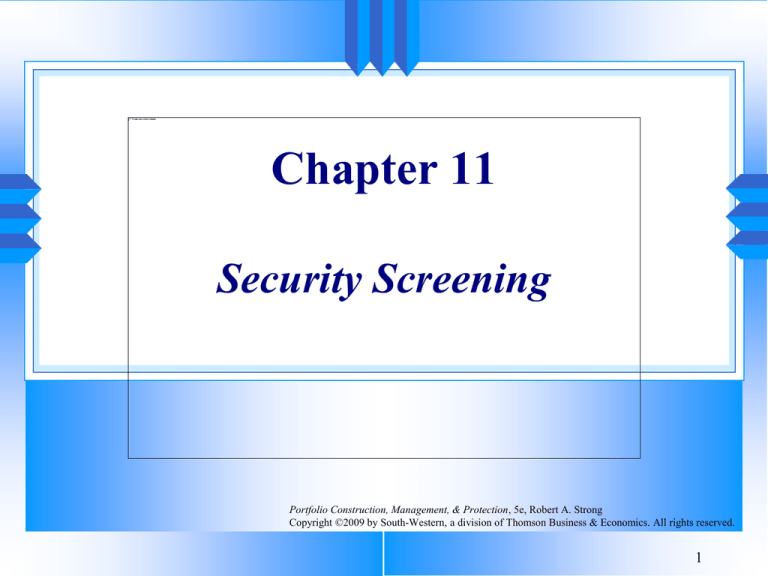
Chapter 11
Security Screening
Portfolio Construction, Management, & Protection, 5e, Robert A. Strong
Copyright ©2009 by South-Western, a division of Thomson Business & Economics. All rights reserved.
1
Never tell people how to do things. Tell them what to
do and they will surprise you with their ingenuity.
General George S. Patton
2
Introduction
Security
screening involves reducing the
security universe down to a manageable
size
Picking
stocks is an art rather than a science
• There is no single best way to choose individual
investments
3
Why Screening Is Necessary
Time
Constraints
Everyday Examples of Screens
4
Time Constraints
The
NYSE, AMEX, and Nasdaq list
thousands of potential investments
• There isn’t time to analyze every security and
process the associated information
Many
people never develop a wellconceived way to deal with the information
overload
5
Everyday Examples of Screens
University
Admission Test
• More people apply for admission than are
ultimately admitted
• Universities use two steps:
– An initial screen
– Closer individual scrutiny for those passing the first
round
6
The Football Team: Another
Everyday Example of Screening
More
players try to join the football team
than the rosters can carry
Coaches
may use screens:
• 40-yard dashes for running backs
• Bench presses for offensive linemen
7
What Constitutes
A Good Screen?
Ease
of Administration
Relevance and Appropriateness
Acceptance by the User
Ordinal Ranking of Screening Criteria
8
Ease of Administration
The
screen should be easy to administer and
implement
e.g.,
narrow stocks down to thinly traded
stocks by using The Wall Street Journal
• Thin trading refers to a security with a
relatively small number of shareholders and a
lack of trading volume
9
Relevance and Appropriateness
Screens
should logically have something to
do with the ultimate objective
For
example, start at the top of the NYSE
listings with your screen
10
Acceptance By the User
Screens
lose value if people fundamentally
disagree with it
For
example, people may not believe in
SAT scores as a screen for admission
11
Ordinal Ranking of
Screening Criteria
Use
a screen pecking order for multiplestage screening:
• The first screen is the one that eliminates the
most alternatives
• The second screen eliminates the next highest
number of alternatives, etc.
12
Screening Processes
Multiple-Stage
Screening
Subjective Screening
Screening with the Popular Press Only
A Quick Risk Assessment Screen with the
Stock Report
13
Multiple-Stage Screening
Most
investment applications require
several screening stages
• e.g., earnings per share by itself is not very
useful
• e.g., in choosing a growth stock, it would not
make sense to search initially for those with the
highest dividend yield
14
Subjective Screening
Not
all screens need to be quantitative
For
example, socially responsible
investing:
• Tobacco stocks, nuclear power, animal testing,
the environment, human rights, etc.
• Best of class investing recognizes that all firms
can be faulted in some way and looks for “role
models” within each industry
15
Screening with the
Popular Press Only
Price/Earnings
Ratio
Dividend Yield
Stock Price
Exchange Listing
Familiarity
52-Week Trading Range
Options Availability
16
Price/Earnings Ratio
Low
PEs are good:
• Investors pay little to get a lot
High
PEs are good:
• The efficient marketplace anticipates that future
earnings will be higher than those of the past
17
Dividend Yield
Dividends
do not materially alter a
recipient’s wealth
People
like to receive dividends:
• Strokes the ego
• Important for income or growth of income
objectives
18
Stock Price
Some
people believe in an optimum trading
range for stock prices
The cost of a share should be merely a
marker
Some people prefer to avoid odd lots
• e.g., investing $2,000 means the stock price
cannot be higher than $20
19
Exchange Listing
Some
clients may want to restrict their
investments to a particular exchange:
• AMEX
• NYSE
• Nasdaq
20
Familiarity
Invest
in companies that you know
something about
Familiarity
is a subjective criterion
21
52-Week Trading Range
“The
stock is trading at the low end of its
annual high and low”
If
the market is efficient, annual highs and
lows are of no value in predicting future
prices
22
Options Availability
Some
people invest in equity issues that
have options available because they are
versatile
Options
information is contained in the
financial press
23
A Quick Risk Assessment
Screen with the Stock Report
ROA
and ROE
Evaluating ROA and ROE
24
ROA and ROE
The
Stock Report contains ten-year histories
of ROA and ROE:
• Useful for a quick comparison of companies:
– ROA is net income after taxes divided by total
assets
– ROE is net income after taxes divided by equity
– If the firm has debt and positive earnings, ROE will
exceed ROA
25
Evaluating ROA and ROE
A
“good, safe investment” has a history of
stable ROA and ROE figures, with ROE
somewhat higher than ROA
If
ROE is substantially higher than ROA,
the firm is heavily leveraged (risky)
26
Sources of Information
Library
Information
• Value Line
• Standard & Poor’s
• Mergent
Internet
• Morningstar
• Yahoo!
• WSJ.com
27
Value Line
The
Value Line Investment Survey:
• Follows 1,700 common stocks
• Rates each stock in two categories:
– Timeliness: the advisability of buying a stock now
– Safety: a measure of potential risk with a stock
• Many market analysts attach considerable
significance to the Value Line report on a stock
28
Value Line Timeliness &
Safety Ranking System
Ranking
1
2
3
4
5
Number of Stocks
with This Ranking
100
300
900
300
100
Meaning
Best
Above average
Average
Below average
Worst
29
Sample
Value Line Report
Source: The Value Line Investment Survey, December 10, 2004. Copyright © 2004 by Value Line Publishing, Inc.: used by permission. For
subscription information to the Value Line Investment Survey, please call (800) 634-3583.
30
Value Line Investment
Analyzer
A
7,500-security database
Can
be screened by more than 300 variables
Can
be used to prepare statistical summaries
and detailed tabular reports
31
Standard & Poor’s
Stock
Report
Compustat
NetAdvantage
32
Stock Report
The
S&P Stock Report is a one-page
document that:
• Is updated quarterly
• Contains a description of a company
• Contains an estimate of what the future holds
for a company
• Contains financial statement information,
dividend payment dates, beta, and other risk
measures
33
Sample
S&P Stock Report
Source: Standard & Poor’s Stock Guide (New York: Standard & Poor’s Corporation, 2004): Reprinted with permission.
34
Compustat
Used
by academic researchers
Available for mainframe and personal
computers
Hundreds of screening variables include:
• Current ratio
• Retained earnings
• Unfunded pension liabilities
35
Mergent
Mergent’s
Manuals
Mergent Dividend Record
36
Mergent’s Manuals
Mergent’s
Manuals:
• Contain seven sets of volumes covering
industrial firms, public utilities, over-thecounter industrials, transportation issues, and
bank/finance issues
• Include the Company Archives Manual, which
provides data on defunct companies since 1996
37
Mergent Dividend Record
Mergent
Dividend Record:
• Contains information on the recent dividend
history of a company, including:
– Payment dates
– Ex-dividend dates
38
Internet
Examples
•
•
•
•
•
of good sources:
http://finance.yahoo.com
http://www.smartmoney.com
http://www.morningstar.com
http://www.fool.com
http://www.bloomberg.com
39
Yahoo!® Finance
40


